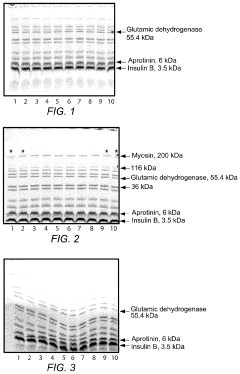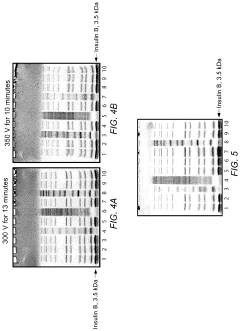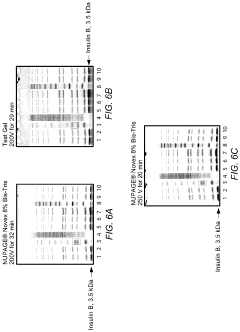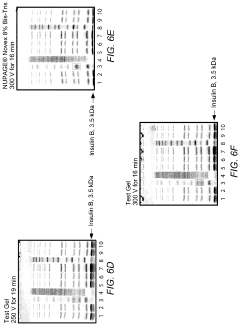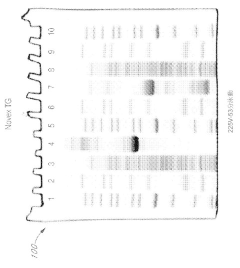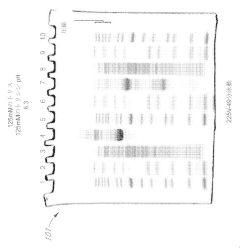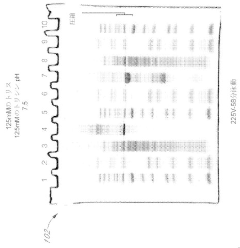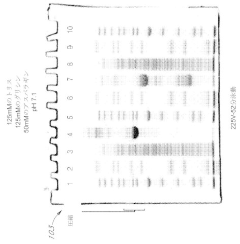How to Ensure Consistent Results in Gel Electrophoresis?
JUL 1, 20259 MIN READ
Generate Your Research Report Instantly with AI Agent
Patsnap Eureka helps you evaluate technical feasibility & market potential.
Gel Electrophoresis Background and Objectives
Gel electrophoresis has been a cornerstone technique in molecular biology since its inception in the 1960s. This method, which separates molecules based on their size and electrical charge, has revolutionized the analysis of DNA, RNA, and proteins. The technique's evolution has been marked by significant improvements in resolution, speed, and reproducibility, making it an indispensable tool in various fields, including genetics, forensics, and medical diagnostics.
The primary objective of gel electrophoresis is to achieve consistent and reliable results across experiments. This consistency is crucial for accurate data interpretation, reproducibility of scientific findings, and the development of standardized protocols in research and clinical settings. However, achieving this consistency has been a persistent challenge due to various factors that can influence the outcome of the electrophoresis process.
The technology behind gel electrophoresis has progressed from simple agarose and polyacrylamide gels to more sophisticated systems incorporating pulsed-field techniques and capillary electrophoresis. These advancements have expanded the range of molecular sizes that can be effectively separated and have improved the overall resolution of the technique. Despite these improvements, the fundamental principles of electrophoretic separation remain the same, emphasizing the need for precise control over experimental conditions.
Recent trends in gel electrophoresis technology focus on automation, miniaturization, and integration with other analytical techniques. These developments aim to enhance reproducibility by minimizing human error and standardizing procedures. Additionally, there is a growing emphasis on developing environmentally friendly and safer alternatives to traditional electrophoresis methods, addressing concerns about the use of toxic chemicals and reducing waste generation.
The quest for consistent results in gel electrophoresis encompasses several key areas of improvement. These include optimizing buffer compositions, refining gel preparation techniques, enhancing sample loading precision, and developing more accurate imaging and analysis systems. Each of these aspects plays a critical role in ensuring the reliability and reproducibility of electrophoresis results.
As we look towards the future, the objectives for gel electrophoresis technology are clear: to further improve consistency, increase sensitivity, and expand applicability across diverse scientific disciplines. Achieving these goals will require interdisciplinary collaboration, combining expertise in molecular biology, materials science, and engineering. The ultimate aim is to transform gel electrophoresis from a powerful but sometimes variable technique into a highly standardized and universally reliable analytical tool.
The primary objective of gel electrophoresis is to achieve consistent and reliable results across experiments. This consistency is crucial for accurate data interpretation, reproducibility of scientific findings, and the development of standardized protocols in research and clinical settings. However, achieving this consistency has been a persistent challenge due to various factors that can influence the outcome of the electrophoresis process.
The technology behind gel electrophoresis has progressed from simple agarose and polyacrylamide gels to more sophisticated systems incorporating pulsed-field techniques and capillary electrophoresis. These advancements have expanded the range of molecular sizes that can be effectively separated and have improved the overall resolution of the technique. Despite these improvements, the fundamental principles of electrophoretic separation remain the same, emphasizing the need for precise control over experimental conditions.
Recent trends in gel electrophoresis technology focus on automation, miniaturization, and integration with other analytical techniques. These developments aim to enhance reproducibility by minimizing human error and standardizing procedures. Additionally, there is a growing emphasis on developing environmentally friendly and safer alternatives to traditional electrophoresis methods, addressing concerns about the use of toxic chemicals and reducing waste generation.
The quest for consistent results in gel electrophoresis encompasses several key areas of improvement. These include optimizing buffer compositions, refining gel preparation techniques, enhancing sample loading precision, and developing more accurate imaging and analysis systems. Each of these aspects plays a critical role in ensuring the reliability and reproducibility of electrophoresis results.
As we look towards the future, the objectives for gel electrophoresis technology are clear: to further improve consistency, increase sensitivity, and expand applicability across diverse scientific disciplines. Achieving these goals will require interdisciplinary collaboration, combining expertise in molecular biology, materials science, and engineering. The ultimate aim is to transform gel electrophoresis from a powerful but sometimes variable technique into a highly standardized and universally reliable analytical tool.
Market Demand for Reliable Gel Electrophoresis
The demand for reliable gel electrophoresis results has been steadily increasing across various sectors of the life sciences industry. This growth is primarily driven by the expanding applications of gel electrophoresis in molecular biology, genetics, and biochemistry research. The global market for gel electrophoresis equipment and consumables is projected to continue its upward trajectory, with a significant portion of this growth attributed to the need for consistent and reproducible results.
In academic and research institutions, there is a growing emphasis on experimental reproducibility, which has led to increased demand for standardized gel electrophoresis protocols and reliable equipment. This trend is further reinforced by the rising number of publications and grant proposals that require robust and consistent data, making reliable gel electrophoresis results a critical factor in research success.
The pharmaceutical and biotechnology industries are also major contributors to the market demand for reliable gel electrophoresis. As drug discovery and development processes become more complex, the need for accurate protein and nucleic acid analysis has intensified. Consistent gel electrophoresis results are essential for quality control in biopharmaceutical production, ensuring the safety and efficacy of therapeutic proteins and other biologics.
Clinical diagnostics represent another significant market segment driving the demand for reliable gel electrophoresis. With the increasing adoption of molecular diagnostic techniques, hospitals and diagnostic laboratories require dependable electrophoresis systems for applications such as genetic testing, cancer diagnostics, and infectious disease detection. The accuracy and reproducibility of results are paramount in these settings, as they directly impact patient care and treatment decisions.
The forensic science field has also contributed to the growing market demand for consistent gel electrophoresis results. DNA profiling and analysis in criminal investigations rely heavily on accurate and reproducible electrophoresis data. As the use of forensic evidence in legal proceedings continues to expand, the need for reliable gel electrophoresis techniques and equipment has become increasingly important.
Emerging markets in developing countries are expected to play a significant role in driving future demand for reliable gel electrophoresis. As these regions invest in research infrastructure and biotechnology capabilities, the need for consistent and high-quality electrophoresis results is likely to grow substantially. This presents opportunities for equipment manufacturers and reagent suppliers to expand their market presence and develop solutions tailored to the specific needs of these emerging markets.
In academic and research institutions, there is a growing emphasis on experimental reproducibility, which has led to increased demand for standardized gel electrophoresis protocols and reliable equipment. This trend is further reinforced by the rising number of publications and grant proposals that require robust and consistent data, making reliable gel electrophoresis results a critical factor in research success.
The pharmaceutical and biotechnology industries are also major contributors to the market demand for reliable gel electrophoresis. As drug discovery and development processes become more complex, the need for accurate protein and nucleic acid analysis has intensified. Consistent gel electrophoresis results are essential for quality control in biopharmaceutical production, ensuring the safety and efficacy of therapeutic proteins and other biologics.
Clinical diagnostics represent another significant market segment driving the demand for reliable gel electrophoresis. With the increasing adoption of molecular diagnostic techniques, hospitals and diagnostic laboratories require dependable electrophoresis systems for applications such as genetic testing, cancer diagnostics, and infectious disease detection. The accuracy and reproducibility of results are paramount in these settings, as they directly impact patient care and treatment decisions.
The forensic science field has also contributed to the growing market demand for consistent gel electrophoresis results. DNA profiling and analysis in criminal investigations rely heavily on accurate and reproducible electrophoresis data. As the use of forensic evidence in legal proceedings continues to expand, the need for reliable gel electrophoresis techniques and equipment has become increasingly important.
Emerging markets in developing countries are expected to play a significant role in driving future demand for reliable gel electrophoresis. As these regions invest in research infrastructure and biotechnology capabilities, the need for consistent and high-quality electrophoresis results is likely to grow substantially. This presents opportunities for equipment manufacturers and reagent suppliers to expand their market presence and develop solutions tailored to the specific needs of these emerging markets.
Current Challenges in Gel Electrophoresis Consistency
Gel electrophoresis is a fundamental technique in molecular biology, widely used for separating and analyzing DNA, RNA, and proteins. Despite its widespread application, achieving consistent results remains a significant challenge. One of the primary issues is the variability in gel preparation, which can lead to inconsistent band migration and resolution. Factors such as gel concentration, buffer composition, and polymerization conditions can all affect the final outcome.
Another major challenge is the inconsistency in sample loading. Uneven sample volumes or improper loading techniques can result in skewed bands and difficult-to-interpret results. This is particularly problematic when comparing multiple samples or when quantitative analysis is required. The use of automated loading systems has helped mitigate this issue to some extent, but human error remains a significant factor in many laboratories.
Electrophoresis conditions also play a crucial role in result consistency. Variations in voltage, current, and run time can dramatically affect band migration and separation. Environmental factors such as temperature fluctuations during the run can cause band distortion or smearing. Many laboratories struggle to maintain consistent conditions across different runs, leading to difficulties in reproducing results.
The quality and purity of reagents used in gel electrophoresis can also impact consistency. Variations in buffer composition, DNA ladder quality, or staining solutions can lead to differences in band visibility and migration patterns. This is particularly challenging when comparing results from different batches of reagents or between different laboratories.
Imaging and analysis of gels present another set of challenges. Inconsistencies in image capture settings, such as exposure time and contrast adjustments, can lead to variations in band intensity and perceived results. The subjectivity involved in manual band analysis can also introduce inconsistencies, especially when multiple researchers are involved in data interpretation.
Standardization of protocols across different laboratories and research groups remains a significant hurdle. The lack of universally accepted standard operating procedures for gel electrophoresis contributes to variability in results between different research teams. This makes it difficult to compare and validate findings across different studies or institutions.
Lastly, the inherent limitations of the gel electrophoresis technique itself pose challenges to consistency. Factors such as DNA secondary structure, sequence-specific migration anomalies, and the resolution limits of agarose or polyacrylamide gels can lead to unexpected or inconsistent results, even when all other variables are controlled.
Another major challenge is the inconsistency in sample loading. Uneven sample volumes or improper loading techniques can result in skewed bands and difficult-to-interpret results. This is particularly problematic when comparing multiple samples or when quantitative analysis is required. The use of automated loading systems has helped mitigate this issue to some extent, but human error remains a significant factor in many laboratories.
Electrophoresis conditions also play a crucial role in result consistency. Variations in voltage, current, and run time can dramatically affect band migration and separation. Environmental factors such as temperature fluctuations during the run can cause band distortion or smearing. Many laboratories struggle to maintain consistent conditions across different runs, leading to difficulties in reproducing results.
The quality and purity of reagents used in gel electrophoresis can also impact consistency. Variations in buffer composition, DNA ladder quality, or staining solutions can lead to differences in band visibility and migration patterns. This is particularly challenging when comparing results from different batches of reagents or between different laboratories.
Imaging and analysis of gels present another set of challenges. Inconsistencies in image capture settings, such as exposure time and contrast adjustments, can lead to variations in band intensity and perceived results. The subjectivity involved in manual band analysis can also introduce inconsistencies, especially when multiple researchers are involved in data interpretation.
Standardization of protocols across different laboratories and research groups remains a significant hurdle. The lack of universally accepted standard operating procedures for gel electrophoresis contributes to variability in results between different research teams. This makes it difficult to compare and validate findings across different studies or institutions.
Lastly, the inherent limitations of the gel electrophoresis technique itself pose challenges to consistency. Factors such as DNA secondary structure, sequence-specific migration anomalies, and the resolution limits of agarose or polyacrylamide gels can lead to unexpected or inconsistent results, even when all other variables are controlled.
Existing Methods for Improving Gel Electrophoresis Consistency
01 Gel composition and preparation
The consistency of gel electrophoresis can be improved by optimizing the gel composition and preparation methods. This includes using specific polymer concentrations, cross-linking agents, and buffer systems to create gels with uniform pore sizes and stable structures. Proper gel preparation techniques, such as degassing and controlled polymerization, contribute to consistent results.- Gel composition and preparation: The consistency of gel electrophoresis can be improved by optimizing the gel composition and preparation methods. This includes using specific polymer concentrations, cross-linking agents, and buffer systems to create gels with uniform pore sizes and stable structures. Proper gel preparation techniques, such as degassing and controlled polymerization, contribute to consistent results.
- Temperature control during electrophoresis: Maintaining consistent temperature throughout the electrophoresis process is crucial for reproducible results. Temperature fluctuations can affect the migration of molecules and the overall separation efficiency. Implementing temperature control systems, such as cooling plates or buffer circulation, helps maintain uniform conditions across the gel.
- Sample loading and well formation: Consistent sample loading and well formation contribute to improved gel electrophoresis results. Techniques for creating uniform wells, such as using specialized combs or automated sample loading systems, ensure equal sample distribution and reduce variability. Proper sample preparation and loading protocols also play a crucial role in achieving consistent results.
- Buffer system optimization: The choice and preparation of buffer systems significantly impact gel electrophoresis consistency. Optimizing buffer composition, concentration, and pH for specific applications can improve separation efficiency and reproducibility. Maintaining consistent buffer conditions throughout the electrophoresis run is essential for reliable results.
- Automated gel electrophoresis systems: Automated gel electrophoresis systems can enhance consistency by reducing human error and standardizing procedures. These systems often incorporate features such as precise temperature control, automated sample loading, and real-time monitoring of electrophoresis conditions. Implementing such systems can lead to more reproducible and reliable results across multiple experiments.
02 Temperature control during electrophoresis
Maintaining consistent temperature throughout the electrophoresis process is crucial for reproducible results. Temperature fluctuations can affect the migration of molecules and the overall separation efficiency. Implementing temperature control systems, such as cooling plates or buffer circulation, helps maintain uniform conditions across the gel.Expand Specific Solutions03 Sample loading and well formation
Consistent sample loading and well formation contribute to improved gel electrophoresis results. Techniques for creating uniform wells, such as using specialized combs or automated sample loading systems, ensure equal sample distribution and reduce variability. Proper sample preparation and loading protocols also play a crucial role in achieving consistent results.Expand Specific Solutions04 Buffer system optimization
The choice and optimization of buffer systems significantly impact gel electrophoresis consistency. Factors such as buffer composition, pH, and ionic strength affect the separation of molecules and the overall performance of the gel. Tailoring buffer systems to specific applications and maintaining consistent buffer conditions throughout the run improve reproducibility.Expand Specific Solutions05 Automated gel electrophoresis systems
Automated gel electrophoresis systems offer improved consistency by minimizing human error and standardizing various aspects of the process. These systems can control multiple parameters, such as voltage, current, and run time, while providing reproducible gel casting, sample loading, and imaging. Integration of automated systems enhances overall consistency and reliability of results.Expand Specific Solutions
Key Players in Gel Electrophoresis Industry
The gel electrophoresis market is in a mature stage, with a global market size estimated to be over $1 billion. The technology is well-established and widely used in research and clinical laboratories. Key players like Life Technologies Corp., Bio-Rad Laboratories, and Tecan Trading AG have developed advanced systems and reagents to ensure consistent results. These companies, along with others such as Expedeon, Inc. and Cytiva Sweden AB, continue to innovate in areas like automated systems, high-throughput applications, and improved resolution. The competitive landscape is characterized by ongoing efforts to enhance reproducibility, sensitivity, and efficiency in gel electrophoresis techniques, with a focus on addressing challenges in result consistency across different laboratories and experimental conditions.
Life Technologies Corp.
Technical Solution: Life Technologies (now part of Thermo Fisher Scientific) has developed the E-Gel electrophoresis system, which uses pre-cast agarose gels with a built-in ethidium bromide stain[10]. This system eliminates variability in gel preparation and staining. They have also introduced the E-Gel Power Snap Electrophoresis Device, which provides precise control over voltage and run time, ensuring consistent separation conditions[11]. Life Technologies' approach focuses on simplifying the electrophoresis process while maintaining high reproducibility through standardized consumables and equipment.
Strengths: User-friendly systems, reduced hands-on time, consistent results for routine applications. Weaknesses: Limited flexibility for non-standard protocols, ongoing costs for proprietary consumables.
Bio-Rad Laboratories, Inc.
Technical Solution: Bio-Rad has developed advanced gel electrophoresis systems with precise temperature control and uniform electric field distribution. Their systems utilize patented electrode design and buffer circulation technology to ensure consistent results[1]. They have also introduced automated gel loading systems that minimize human error and improve reproducibility[2]. Bio-Rad's precast gels are manufactured with tight quality control measures, ensuring batch-to-batch consistency in gel composition and pore size[3]. Additionally, they offer specialized imaging systems with advanced software for accurate and reproducible gel analysis[4].
Strengths: Comprehensive solution from gel preparation to analysis, high reproducibility, and advanced automation. Weaknesses: Higher cost compared to basic systems, may require specialized training for optimal use.
Innovative Approaches in Gel Electrophoresis Optimization
System for rapid high-resolution GEL electrophoresis
PatentActiveUS20190391113A1
Innovation
- The development of electrophoretic systems and formulations that allow for higher field strengths up to 50% more than conventional systems, using a discontinuous buffer system with specific gel amine and ampholyte buffers, and a pH range of 5.5 to 7.5, enabling faster separation of proteins within 30 minutes or less, even at higher voltages.
Electrophoresis gels with extended shelf life and high performance
PatentActiveJP2018530758A
Innovation
- Formulations of polyacrylamide gels with a near-neutral pH (6.5 to 7.5) using gel amine buffers, primary gel ampholytes, and conjugated gel ampholytes such as threonine and serine, which maintain gel stability and improve separation efficiency.
Quality Control Standards in Gel Electrophoresis
Quality control standards play a crucial role in ensuring consistent results in gel electrophoresis. These standards encompass various aspects of the experimental process, from sample preparation to data analysis. One of the primary quality control measures is the use of standardized protocols for sample preparation and loading. This includes precise measurement of DNA or protein concentrations, consistent use of loading buffers, and careful handling of samples to prevent degradation or contamination.
Gel preparation is another critical area where quality control standards are essential. The concentration and composition of the gel must be carefully controlled to ensure reproducible separation of molecules. This involves using high-quality reagents, precise measurements, and consistent polymerization conditions. Regular calibration and maintenance of electrophoresis equipment, including power supplies and gel tanks, are also vital to maintain consistent performance.
The use of molecular weight markers or ladders is a fundamental quality control standard in gel electrophoresis. These markers serve as reference points for size determination and allow for comparison between different gels and experiments. It is important to use markers appropriate for the size range of the molecules being analyzed and to include them in every gel run.
Standardization of running conditions is another key aspect of quality control. This includes maintaining consistent voltage, current, and running time across experiments. Environmental factors such as temperature can also affect gel electrophoresis results, so controlling the ambient conditions or using temperature-controlled systems can improve reproducibility.
Post-electrophoresis processes, such as staining and imaging, also require quality control measures. Using standardized staining protocols, including consistent staining times and concentrations, helps ensure comparable results between experiments. For imaging, calibration of imaging equipment and use of consistent exposure settings are important for accurate quantification and comparison of band intensities.
Documentation and record-keeping are integral parts of quality control in gel electrophoresis. Detailed lab notebooks, standardized data collection forms, and electronic laboratory information management systems (LIMS) can help track experimental conditions, reagent lots, and equipment settings. This information is invaluable for troubleshooting inconsistencies and ensuring reproducibility over time.
Regular proficiency testing and inter-laboratory comparisons can also serve as quality control measures. These practices help identify systematic errors or biases in individual laboratories and promote standardization across different research groups or facilities. Additionally, the use of positive and negative controls in each experiment provides a means to validate the performance of the electrophoresis system and detect any anomalies.
Gel preparation is another critical area where quality control standards are essential. The concentration and composition of the gel must be carefully controlled to ensure reproducible separation of molecules. This involves using high-quality reagents, precise measurements, and consistent polymerization conditions. Regular calibration and maintenance of electrophoresis equipment, including power supplies and gel tanks, are also vital to maintain consistent performance.
The use of molecular weight markers or ladders is a fundamental quality control standard in gel electrophoresis. These markers serve as reference points for size determination and allow for comparison between different gels and experiments. It is important to use markers appropriate for the size range of the molecules being analyzed and to include them in every gel run.
Standardization of running conditions is another key aspect of quality control. This includes maintaining consistent voltage, current, and running time across experiments. Environmental factors such as temperature can also affect gel electrophoresis results, so controlling the ambient conditions or using temperature-controlled systems can improve reproducibility.
Post-electrophoresis processes, such as staining and imaging, also require quality control measures. Using standardized staining protocols, including consistent staining times and concentrations, helps ensure comparable results between experiments. For imaging, calibration of imaging equipment and use of consistent exposure settings are important for accurate quantification and comparison of band intensities.
Documentation and record-keeping are integral parts of quality control in gel electrophoresis. Detailed lab notebooks, standardized data collection forms, and electronic laboratory information management systems (LIMS) can help track experimental conditions, reagent lots, and equipment settings. This information is invaluable for troubleshooting inconsistencies and ensuring reproducibility over time.
Regular proficiency testing and inter-laboratory comparisons can also serve as quality control measures. These practices help identify systematic errors or biases in individual laboratories and promote standardization across different research groups or facilities. Additionally, the use of positive and negative controls in each experiment provides a means to validate the performance of the electrophoresis system and detect any anomalies.
Environmental Factors Affecting Gel Electrophoresis Results
Gel electrophoresis is a widely used technique in molecular biology for separating and analyzing DNA, RNA, and proteins. However, achieving consistent results can be challenging due to various environmental factors that can influence the outcome. Temperature plays a crucial role in gel electrophoresis, affecting both the gel's structure and the migration of molecules. Fluctuations in ambient temperature can lead to uneven gel polymerization and inconsistent band patterns. Maintaining a stable temperature throughout the process is essential for reproducible results.
Humidity is another significant environmental factor that can impact gel electrophoresis. High humidity levels can cause gels to swell, altering their pore size and affecting molecule migration rates. Conversely, low humidity can lead to gel dehydration, resulting in distorted band patterns. Controlling humidity in the laboratory environment is vital for ensuring consistent gel performance.
The quality and purity of the water used in gel preparation and buffer solutions can significantly affect electrophoresis results. Impurities or contaminants in the water may interfere with gel polymerization or alter the electrical conductivity of the buffer, leading to inconsistent band migration. Using deionized or ultrapure water is crucial for maintaining reproducibility.
Vibrations and mechanical disturbances can also impact gel electrophoresis results. Even minor vibrations during gel polymerization or electrophoresis can cause uneven gel formation or disturb the migration of molecules, resulting in blurred or distorted bands. Placing electrophoresis equipment on stable surfaces and minimizing nearby vibration sources is essential for consistent outcomes.
Light exposure can affect certain aspects of gel electrophoresis, particularly when working with light-sensitive reagents or fluorescent dyes. Excessive light exposure can lead to photobleaching of fluorescent markers or degradation of light-sensitive samples. Proper shielding from light during gel preparation and electrophoresis is necessary to maintain sample integrity and ensure accurate results.
Atmospheric pressure variations, although often overlooked, can influence gel electrophoresis results, especially in laboratories at high altitudes. Changes in pressure can affect the boiling point of solutions and impact the evaporation rate of buffers, potentially altering their concentration during long electrophoresis runs. Awareness of these effects and appropriate adjustments to protocols may be necessary in certain geographical locations.
By carefully controlling and monitoring these environmental factors, researchers can significantly improve the consistency and reproducibility of gel electrophoresis results. Implementing standardized protocols that account for these variables and utilizing environmental control systems in the laboratory can help mitigate their impact and ensure more reliable experimental outcomes.
Humidity is another significant environmental factor that can impact gel electrophoresis. High humidity levels can cause gels to swell, altering their pore size and affecting molecule migration rates. Conversely, low humidity can lead to gel dehydration, resulting in distorted band patterns. Controlling humidity in the laboratory environment is vital for ensuring consistent gel performance.
The quality and purity of the water used in gel preparation and buffer solutions can significantly affect electrophoresis results. Impurities or contaminants in the water may interfere with gel polymerization or alter the electrical conductivity of the buffer, leading to inconsistent band migration. Using deionized or ultrapure water is crucial for maintaining reproducibility.
Vibrations and mechanical disturbances can also impact gel electrophoresis results. Even minor vibrations during gel polymerization or electrophoresis can cause uneven gel formation or disturb the migration of molecules, resulting in blurred or distorted bands. Placing electrophoresis equipment on stable surfaces and minimizing nearby vibration sources is essential for consistent outcomes.
Light exposure can affect certain aspects of gel electrophoresis, particularly when working with light-sensitive reagents or fluorescent dyes. Excessive light exposure can lead to photobleaching of fluorescent markers or degradation of light-sensitive samples. Proper shielding from light during gel preparation and electrophoresis is necessary to maintain sample integrity and ensure accurate results.
Atmospheric pressure variations, although often overlooked, can influence gel electrophoresis results, especially in laboratories at high altitudes. Changes in pressure can affect the boiling point of solutions and impact the evaporation rate of buffers, potentially altering their concentration during long electrophoresis runs. Awareness of these effects and appropriate adjustments to protocols may be necessary in certain geographical locations.
By carefully controlling and monitoring these environmental factors, researchers can significantly improve the consistency and reproducibility of gel electrophoresis results. Implementing standardized protocols that account for these variables and utilizing environmental control systems in the laboratory can help mitigate their impact and ensure more reliable experimental outcomes.
Unlock deeper insights with Patsnap Eureka Quick Research — get a full tech report to explore trends and direct your research. Try now!
Generate Your Research Report Instantly with AI Agent
Supercharge your innovation with Patsnap Eureka AI Agent Platform!
